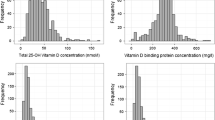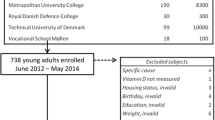Abstract
Introduction
Previously we reported seasonal variation in 25-hydroxyvitamin D (25OHD) levels in postmenopausal women living in a subtropical climate. Because studies have suggested that there are gender differences in 25OHD levels, we sought to determine (1) the levels and determinants of 25OHD in men drawn from the same community, (2) whether seasonal variation of 25OHD occurs in men at this latitude (37°S), and (3) whether these findings were comparable to those we previously observed in postmenopausal women.
Methods
Cross-sectional study of 378 healthy, middle-aged and older community-dwelling men in Auckland, New Zealand.
Results
The mean 25OHD (SD) level was 85 (31) nmol/l. We found significant seasonal variation in 25OHD levels (peak in autumn 103 nmol/l, nadir in spring 59 nmol/l). Vitamin D insufficiency (25OHD <50nmol/l) was uncommon (prevalence in summer 0–17%, in winter 0–20%). The major determinants of 25OHD were month of blood sampling, fat percentage, physical activity, and serum albumin. Men had higher levels of 25OHD throughout the year than women did, a finding that persisted after adjusting for potential confounding factors. In men and women the determinants of 25OHD were similar.
Conclusion
There is significant seasonal variation in 25OHD levels in men living in a subtropical climate. In contrast to postmenopausal women, men have low rates of suboptimal vitamin D status, even in winter. Routine vitamin D supplementation for this population of men is not warranted.

Similar content being viewed by others
References
van der Wielen RP, Lowik MR, van den Berg H et al (1995) Serum vitamin D concentrations among elderly people in Europe. Lancet 346:207–210
Dawson-Hughes B, Harris SS, Dallal GE (1997) Plasma calcidiol, season, and serum parathyroid hormone concentrations in healthy elderly men and women. Am J Clin Nutr 65:67–71
Jacques PF, Felson DT, Tucker KL et al (1997) Plasma 25-hydroxyvitamin D and its determinants in an elderly population sample. Am J Clin Nutr 66:929–936
Carnevale V, Modoni S, Pileri M et al (2001) Longitudinal evaluation of vitamin D status in healthy subjects from southern Italy: seasonal and gender differences. Osteoporos Int 12:1026–1030
Maggio D, Cherubini A, Lauretani F et al (2005) 25(OH)D Serum levels decline with age earlier in women than in men and less efficiently prevent compensatory hyperparathyroidism in older adults. J Gerontol A Biol Sci Med Sci 60:1414–1419
Lucas JA, Bolland MJ, Grey AB et al (2005) Determinants of vitamin D status in older women living in a subtropical climate. Osteoporos Int 16:1641–1648
Jackson R (2000) Updated New Zealand cardiovascular disease risk-benefit prediction guide. BMJ 320:709–710
Wilson PW, Paffenbarger RS Jr, Morris JN et al (1986) Assessment methods for physical activity and physical fitness in population studies: report of a NHLBI workshop. Am Heart J 111:1177–1192
Carter GD, Carter CR, Gunter E et al (2004) Measurement of vitamin D metabolites: an international perspective on methodology and clinical interpretation. J Steroid Biochem Mol Biol 89–90:467–471
Scragg R, Holdaway I, Jackson R et al (1992) Plasma 25-hydroxyvitamin D3 and its relation to physical activity and other heart disease risk factors in the general population. Ann Epidemiol 2:697–703
Need AG, Morris HA, Horowitz M et al (1993) Effects of skin thickness, age, body fat, and sunlight on serum 25-hydroxyvitamin D. Am J Clin Nutr 58:882–885
Arunabh S, Pollack S, Yeh J et al (2003) Body fat content and 25-hydroxyvitamin D levels in healthy women. J Clin Endocrinol Metab 88:157–161
Snijder MB, van Dam RM, Visser M et al (2005) Adiposity in relation to vitamin D status and parathyroid hormone levels: a population-based study in older men and women. J Clin Endocrinol Metab 90:4119–4123
Wortsman J, Matsuoka LY, Chen TC et al (2000) Decreased bioavailability of vitamin D in obesity. Am J Clin Nutr 72:690–693
Nowson CA, Margerison C (2002) Vitamin D intake and vitxamin D status of Australians. Med J Aust 177:149–152
Hill T, Collins A, O’Brien M et al (2005) Vitamin D intake and status in Irish postmenopausal women. Eur J Clin Nutr 59:404–410
Omdahl JL, Garry PJ, Hunsaker LA et al (1982) Nutritional status in a healthy elderly population: vitamin D. Am J Clin Nutr 36:1225–1233
Burnand B, Sloutskis D, Gianoli F et al (1992) Serum 25-hydroxyvitamin D: distribution and determinants in the Swiss population. Am J Clin Nutr 56:537–542
Jones WO, Harman CR, Ng AK et al (1999) Incidence of malignant melanoma in Auckland, New Zealand: highest rates in the world. World J Surg 23:732–735
Sherman SS, Hollis BW, Tobin JD (1990) Vitamin D status and related parameters in a healthy population: the effects of age, sex, and season. J Clin Endocrinol Metab 71:405–413
Holick MF, Matsuoka LY, Wortsman J (1989) Age, vitamin D, and solar ultraviolet. Lancet 2:1104–1105
Chapuy MC, Preziosi P, Maamer M et al (1997) Prevalence of vitamin D insufficiency in an adult normal population. Osteoporos Int 7:439–443
Szulc P, Munoz F, Marchand F et al (2003) Role of vitamin D and parathyroid hormone in the regulation of bone turnover and bone mass in men: the MINOS study. Calcif Tissue Int 73:520–530
Woitge HW, Scheidt-Nave C, Kissling C et al (1998) Seasonal variation of biochemical indexes of bone turnover: results of a population-based study. J Clin Endocrinol Metab 83:68–75
Acknowledgements
We wish to thank Dr. Richard McKenzie for supplying the UV data, and Margaret Matson and the laboratory staff of Labplus for the data on the comparisons between the 25OHD assays.
Author information
Authors and Affiliations
Corresponding author
Rights and permissions
About this article
Cite this article
Bolland, M.J., Grey, A.B., Ames, R.W. et al. Determinants of vitamin D status in older men living in a subtropical climate. Osteoporos Int 17, 1742–1748 (2006). https://doi.org/10.1007/s00198-006-0190-2
Received:
Accepted:
Published:
Issue Date:
DOI: https://doi.org/10.1007/s00198-006-0190-2




